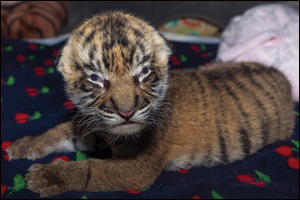Saving Suka: A Kidney Week story
Click Here to Manage Email Alerts
As more than 11,000 nephrology practitioners and researchers from all over the world descend upon San Diego this month for Kidney Week, there is a special story to tell from the San Diego Zoo Safari Park.
Suka (meaning “loved” in the Malay language) is a rare Sumatran tiger born in September 2015 at the San Diego Zoo Safari Park. His mother rejected him on the third day, and he was hand-reared by the tiger staff at the park. However, even with supplemented formula for carnivores (goat milk and nutrients), Suka failed to thrive. As he was being moved to the Paul Harter Veterinary Medical Center, Suka arrested. CPR was started, and stat lab work showed a critical calcium level (> 9 mEq/dL) and profound hyponatremia (120 mg/dL). Nadine Lamberski, DVM, DACZM, DECZM, of San Diego Zoo Global, said Suka was immediately placed on a subcutaneous fluid drip (0.9% NaCl).

Prednisolone and fludrocortisone were started for what was feared to be an Addisonian crisis. However, just as often is the case of our human patients, the murky diagnosis started to get murkier. Urine culture from the initial labs grew Klebsiella pneumonia and an Enterococcus spp. The veterinarians at the park began oral clavamox for the urinary tract infection.
Lab results
Lab results were followed closely, but the hyperkalemia and hyponatremia continued. The veterinarians began to suspect pseudohypoaldosteronism secondary to a urinary tract infection (UTI) in the tiger cub. An ultrasound showed hyperechoic debris swirling in the urinary bladder. The same debris was also visible in both renal pelvises with a bilateral dilation of the renal pelvises. Confirmatory ACTH stimulation test made the final diagnosis: pseudohypoaldosteronism with a significantly elevated aldosterone level (> 4572 pmol/L).
As there are no tiger nephrologists, park veterinarians consulted their local small animal veterinary colleagues. However, most of the answers were in the human literature, specifically the pediatric nephrology literature.

Pseudohypoaldosteronism (PHA) is described in the pediatric literature as either type 1 or type 2. Type 1 can be primary or transient, whereas type 2 is generally congenital. Transient type 1 PHA is usually caused by an UTI and/or a congenital malformation leading to a UTI, which was what the tiger cub had. Park veterinarians consulted with their veterinary colleagues and used the nephrology human literature to diagnose, treat and save Suka.
Suka was treated for several months with subcutaneous NaCl 0.9% to flush out the kidney debris. Suka was also continued on oral antibiotics. Serial fractional excretion of urine was followed and showed high levels of sodium and calcium. As the UTI cleared with treatment, these values improved and after 2 months of treatment were normal. Serum electrolytes also dropped into normal ranges. Suka was introduced into the general tiger population at the San Diego Zoo Safari Park with great fanfare.
Survival of a species

During the next year, Suka continued to grow and flourish. The care he received by the entire staff at the park was responsible for the increased survival of a species. Without it, we would have lost an endangered Sumatran tiger. Suka now lives with his brother Nelson. If you get time to visit the San Diego Zoo or the much larger San Diego Zoo Safari Park, take the opportunity.
As far as Suka, he seems little aware of his importance or the journey he made with the help of phenomenal veterinary care from a team that pulled out all stops to save one cub and from the nephrology community which has researched and published lifesaving literature on a rare, but potentially fatal, condition.
- For more information:
- Kim Zuber, PA-C, is a physician assistant based in San Diego and is co-author of the Advanced Practice column.
